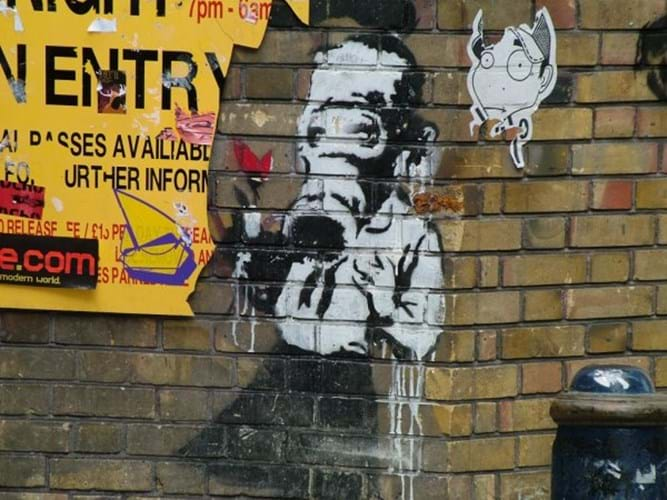
Image via Wikimedia Commons.
Banksy seems to have difficulty staying out of the news despite apparently determined anonymity, and of course this article only adds to it.
One of his pictures was recently reported as sold at Sotheby’s for £1.2m, double the low estimate.
And just before that and still ongoing is an interesting saga relating to one of his graffiti projects.
Birmingham’s Jewellery Quarter woke on December 9 last year to a new Banksy mural, centred on the homeless community during the Christmas period. The mural is positioned with a bench alongside it, with the depiction of two reindeer seemingly pulling the bench.
Banksy accompanied his work with a video on social media, showing homeless man Ryan settling down for the night.
This empathetic message in support of the homeless was unfortunately outshone by the fact that the mural was defaced. Just hours after the work emerged, an unknown male spray-painted red noses onto the existing Banksy artwork.
Right of integrity
Banksy, should he choose, might wish to consider his ‘moral rights’, and specifically what is known as the ‘right of integrity’.
Under the Copyright, Designs and Patents Act 1988, the author of a copyright work has the right to object to ‘derogatory treatment’ of his or her work. Readers may be interested to know that even if you buy it and own the work, you can’t just do what you like with it – the artist may certainly object if for example, you choose to chop it up and display it in little pieces – as once happened.
The treatment of a work (eg ‘an addition, deletion or alteration’) is considered derogatory if it amounts to a distortion or mutilation of the work, or otherwise is prejudicial to the ‘honour’ or ‘reputation’ of the author. If the treatment can be considered derogatory, the author may have a claim. Generally, much will be determined objectively, looking to evidence for example from the public to establish whether the author has been prejudiced. It is not enough that the author himself is aggrieved.
Banksy may have another problem here because of his chosen anonymity. The concept of ‘reputation’ relies on what is said or believed about the author. Prejudice against an author’s ‘honour’ has been described as being an affront to the author’s personality and dignity, and entails a respect for the author’s position as a creator.
One could easily see a defendant claiming that Banksy’s determination to remain hidden makes his reputation and honour obscure.
It may also be difficult to argue that the treatment of the work here has been prejudicial to the author’s reputation, given that the public have generally jumped to the defence of the artist.
Screen to cover
A Perspex screen was then obtained to cover the work and protect it. This sort of act probably enhanced the reputation of the work and the artist – rather than diminishing it.
Ironically the plastic screen was vandalised. Not being a work of art (presumably), the screen’s creator won’t be able to make a claim for derogatory treatment.
At least that was what I thought when I first drafted this piece. I subsequently learned that even the screen went to auction for charity, selling for £2300 at Fellows. Maybe it was a work of art after all, or perhaps the price was due to the quality of the etchings of the vandalising graffiti artist who defaced it.
And so it goes on – the latest being that a Banksy mural in Bristol created for Valentine’s Day has now been vandalised. The bottom line seems to be that anything to do with Banksy seems very bankable.
Milton Silverman is senior commercial dispute resolution partner at Streathers Solicitors LLP, London.














